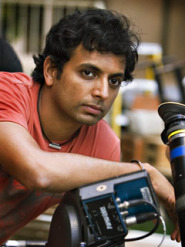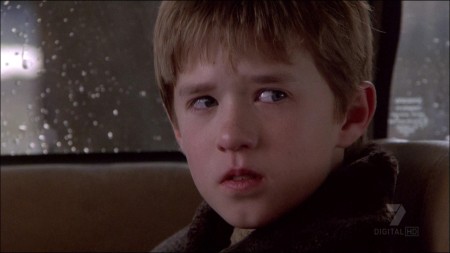 Hi, Tim here. This weekend sees the release of After Earth, the latest of 2013’s surprisingly well-stocked slate of post-apocalyptic sci-fi thrillers, starring Will and Jaden Smith. These are all things that are proudly trumpeted by the ad campaign. What is conspicuously not trumpeted, proudly or otherwise, is the identity of the film’s director M. Night Shyamalan, who for the first time since his gigantic 1999 breakthrough The Sixth Sense is not mentioned by name in the ad campaign for his latest feature.
Hi, Tim here. This weekend sees the release of After Earth, the latest of 2013’s surprisingly well-stocked slate of post-apocalyptic sci-fi thrillers, starring Will and Jaden Smith. These are all things that are proudly trumpeted by the ad campaign. What is conspicuously not trumpeted, proudly or otherwise, is the identity of the film’s director M. Night Shyamalan, who for the first time since his gigantic 1999 breakthrough The Sixth Sense is not mentioned by name in the ad campaign for his latest feature.
This is, undoubtedly, because Shyamalan been steadily pissing away audience goodwill almost since the moment he started earning it, with each new film he’s made being widely regarded as worse than the one preceding it (a steady downward trend on Metacritic, down with just a single blip up on Rotten Tomatoes). With After Earth appearing to flatten or slightly reverse this trend, it’s as good a time as any to explore the exact shape of Shyamalan’s fall in such a relatively short time, trying to figure out exactly how the man anointed as “The Next Spielberg” at a tender age ended up becoming one of modern cinephilia’s greatest punchlines.

THE SIXTH SENSE (1999): Wunderkind
The 29-year-old’s third feature turned out to be a massive hit, landing Best Picture and Best Director Oscar nominations. While his urban ghost story really isn’t that good, it holds up well, despite all the clichés and bad habits that started right here (the twist ending especially): it builds up spooky atmosphere terrifically well, and it has a resolutely smart visual language. Sure, most of what makes the film work was aped from established directors and classic movies, but skillfull mimicry is still, well, skillful. Some of the luster has been knocked off the movie in the intervening years, but in some ways, it seems even more impressive now, given what we know about the limitations of Shyamalan’s talent.

UNBREAKABLE (2000): Blank Check
A film ahead of its time: if it had come out 10 years later, in the thick of the superhero boom, it might have seemed boldly revisionist, instead of weirdly unfocused. That said, relying for the second time on Bruce Willis paid off well for Shyamalan: his story of an everyday working class man of steel has a weathered fleshiness that only a middle-aged Willis could provide. Whether the film can be called entirely successful, or not (speaking personally, I find it lacks narrative momentum), it is definitely unique, the kind that comes when a talented young filmmaker gets a free pass from a big success: idiosyncratic, speaking to deeply personal interests, trying to do something different. If it’s a misfire, it’s a forgivable one.

SIGNS (2002): Brand Name
The final Shyamalan film generally regarded as good, its biggest strength is also its biggest problem: its best parts are copied from other, better filmmakers, primarily Alfred Hitchcock’s The Birds and George A. Romero’s Night of the Living Dead. It’s thematically overweening, dragging a deeply felt message about religious faith into its by-the-numbers alien invasion thriller. That kind of marriage can work, it takes a bolder filmmaker with fresher ideas than Shyamalan, who had apparently learned the wrong lessons from the cool reception of Unbreakable: stick within a straightforward genre, and mimic other directors’ technique, even when it doesn’t necessarily fit the story you’re trying to tell. Certainly, the film’s successes as a thriller only throw into sharp relief the wobbliness of the human story.

THE VILLAGE (2004): One-Trick Pony
Not much is truly wrong with this movie, the one where Shyamalan’s reputation finally tanked: the biggest problem is its ridiculous twist ending, which might have worked at the end of a 24-minute Twilight Zone episode but feels cheap and smarmy as the climax of a feature film. Outside of that, though (and by no means is that a little thing) The Village boasts reasonably strong visuals (the use of color recalls The Sixth Sense), and so far as it’s a horror film, it’s a pretty solid one. The stilted, old-timey dialogue is a huge problem, undoubtedly, and a couple dreadful performances make the whole seem worse than it really is. But the film’s biggest sin is that of a director finally lapsing into self-copying, with the typical draining of enthusiasm that comes with it.

LADY IN THE WATER (2006): God Complex
The film’s toxic reception can be blamed on two terrible elements: first was retaliating for the poor reviews for The Village by making this film’s villain a shrill strawman of a literary critic. The other was Shyamalan casting himself in the Christ-like role of a writer in a metaphor for how wonderful stories – like this one, goes the implication – can save humanity, or something. Seven years after The Sixth Sense provided the kind of notices that any young director would kill to have, it would appear that Shyamalan hadn’t given up on the idea that he was unbelievably special, and the arrogance in this film is its most off-putting trait, followed by the murkiness of its exposition; but at the very least, Shyamalan still had a decent eye for memorable imagery.

THE HAPPENING (2008): Losing It
Then he lost that eye. Part of that is due to the hokey-as-hell script he stuck himself with: killer plants driving people insane! And it would take an impeccably talented filmmaker, not just a gifted mockingbird, to make the sight of trees blowing in the wind look as terrifying as The Happening desperately needs them to. In every previous one of his films, Shyamalan was able to use strong technique to paper over the dubious contrivances of his scenarios, but in this case, the contrivance marches up front and center, and it’s hard to think about anything beyond how damn hokey the whole thing is. Getting dreadful performances out of Mark Wahlberg and Zooey Deschanel at her all-time glassiest certain doesn’t help matters.

THE LAST AIRBENDER (2010): Incompetence
Working for the first time from a pre-existing story might have been a step in the right direction; it was the only one. Not only did Shyamalan coax first-timer Noah Ringer into giving one of the all-time worst performances in the history of child actors, he did it in the midst of his first outright ugly movie (shot by the reliably picturesque Andrew Lesnie, no less), as hapless camera angles and unreadable dialogue jostled for prominence in what ends up feeling like the world’s most expensive middle school drama club video. What could lead a formerly talented filmmaker to such depths as this is impossible to guess: far from the stylist who created such atmosphere in his early films, even as the scripts got worse and worse, the visuals here actively conspire to make the ill-expressed story even harder to follow.

And this brings us back to 2013, and After Earth, Shyamalan’s first project from a previously written screenplay. Having finally turned into a journeyman director can only be a step in the right direction, as whatever sense of infallibility that crept into the director’s work from all that early praise and led him into such indulgent, failed stories will hopefully be scrubbed out. It would nice to have the director of The Sixth Sense back, because popcorn movies with that much class and creativity are always in demand.